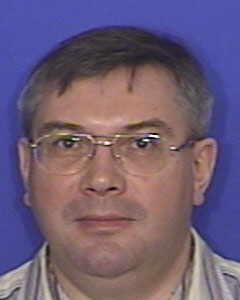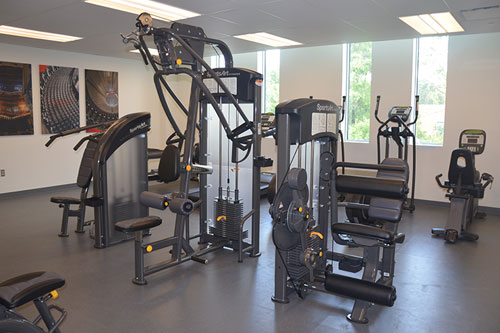
CEBAF Accelerator Upgrade Complete: Initial Operations Set to Begin While Experimental Equipment Upgrades Continue |
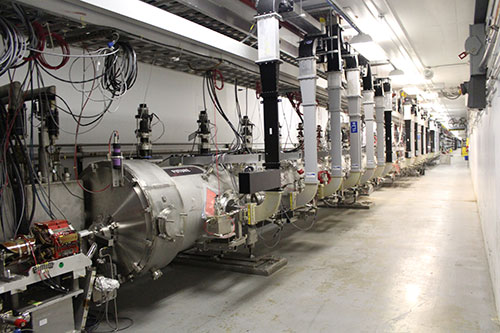
This photo shows a few of the 10 C100 cryomodules added to the CEBAF accelerator as part of the 12 GeV Upgrade. Five of the new cryomodules were installed in the North Linac and five in the South Linac. Jefferson Lab received formal approval on July 30 from the U.S. Department of Energy to begin initial operations of the Continuous Electron Beam Accelerator Facility (CEBAF) as part of its ongoing $338 million upgrade. With the approval of Critical Decision-4A, Accelerator Project Completion and Start of Operations, by DOE, Jefferson Lab staff can continue development activities to bring the accelerator up to its full capabilities, while also continuing to install upgraded instrumentation in two of the three existing experimental halls (B and C) and implementing new instrumentation in its newest experimental hall (D). This very important milestone marks the completion of the accelerator and civil portions of the 12 GeV CEBAF Upgrade project necessary to mark the transition to initial operations of the facility. Once fully completed, the newly upgraded CEBAF will become an unprecedented tool for the study of the basic building blocks of the visible universe. "My sincere congratulations to the entire team on reaching this very important milestone in the project in such fine fashion. It is a tribute to the dedication, skill, and knowledge of everyone--from the people on the line, to the accelerator staff, the project management team, the scientists, and laboratory management. Outstanding!" said Dr. Tim Hallman, Associate Director of Science for Nuclear Physics in DOE’s Office of Science......... more |
|
|
Lab Plans Three Public Events for Virginia Science Festival Week; Talk about Science Conducted at Lab Planned for Oct. 7
|
Secretary Moniz Showcases National Labs on the Hill; Event Highlights DOE Labs’ Contributions to U.S. Competitiveness, Innovation
|
Ian Balitsky Receives ODU Faculty Research Achievement Award A member of Jefferson Lab’s Theory group has received an Old Dominion University Faculty Research Achievement Award....... more |
||
|
|
||||
Below the Fold:
|
||||
|
|
||||
CEBAF Accelerator Upgrade Complete: Initial Operations Set to Begin While Experimental Equipment Upgrades Continue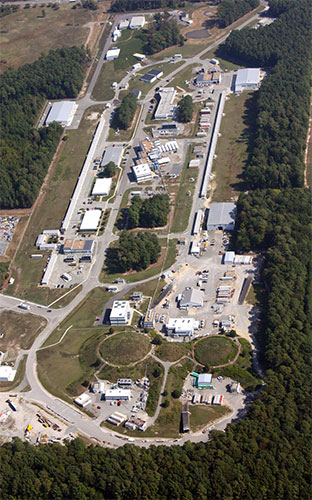
This aerial photo shows the footprint of the CEBAF accelerator, the outline of the three existing experimental areas (Halls A, B and C are the circles at bottom of image); and the new experimental area, Hall D (upper left corner). The lab is currently installing upgraded instrumentation in Halls B and C and implementing new instrumentation in Hall D. Jefferson Lab received formal approval on July 30 from the U.S. Department of Energy to begin initial operations of the Continuous Electron Beam Accelerator Facility (CEBAF) as part of its ongoing $338 million upgrade. The CEBAF accelerator, an Office of Science User Facility, produces a stream of charged electrons that scientists use to probe the nucleus of the atom, its protons and neutrons, and their quarks and gluons. CEBAF delivered 6 GeV electrons (electrons with 6 billion electron-volts in energy) in its original configuration. Construction began in 2008 for the 12 GeV Upgrade to double CEBAF's maximum operational energy and includes the construction of the fourth experimental hall, as well as upgrades to equipment in the existing halls. Following completion of the CEBAF accelerator upgrade tasks this spring, the machine achieved several critical commissioning milestones that qualified it for consideration of this next approval step. The accelerator has been in a scheduled maintenance period since May 11. Now, with the approval of Critical Decision-4A, Jefferson Lab staff and visiting scientists may continue commissioning the accelerator and dependent upon funding availability, some limited early physics running may be feasible as the capabilities of the machine are ramped up and instrumentation is implemented. "This approval comes five months ahead of schedule, a testament to the diligent efforts of everyone involved with the project," said Hugh Montgomery, Jefferson Lab director. As Jefferson Lab performs beam development activities to bring the accelerator up to its full capabilities, the project continues to work toward CD-4B, Approve Experimental Equipment Project Completion, which is scheduled for September 2017. "I sincerely hope everyone can take a few moments to look up from their toils and savor this important accomplishment – right before wiping their brow, taking a big breath, and continuing with renewed spirit and vigor to achieve the grand success of CD-4B," Hallman said. "Our journey continues, but this is a really nice scenic overlook we have reached along the way." By Kandice Carter |
||||
|
|
||||
Lab Plans Three Public Events for Virginia Science Festival Week; Talk about Science Conducted at Lab Planned for Oct. 7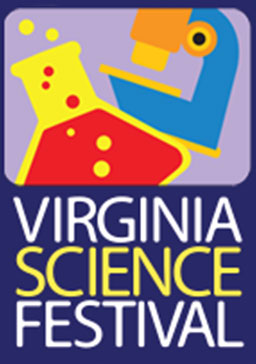 In conjunction with the inaugural Virginia Science Festival being held across the Commonwealth Oct. 4-11, Jefferson Lab will hold three events. Learn About the Building Blocks of Matter on Oct. 7 Jefferson Lab Staff Scientist Douglas Higinbotham will present “Studying the Building Blocks of Matter” beginning at 7 p.m. on Oct. 7 in the CEBAF Center auditorium. Since ancient times, humans have inquired about what makes up the world around them. In antiquity, the Greeks believed the world to be made up of earth, water, air, fire and the aether. Today, researchers at Jefferson Lab study quarks and gluons: what we now believe to be the fundamental building blocks of the atomic nucleus, according to Higinbotham. Jefferson Lab's research on the building blocks of matter will be presented along with a discussion about why you should care. The program is free and open to anyone interested in learning more about science. The program will last about one hour and will include a question-and-answer period at the end. Doors open at 6:30 p.m. Seating is limited and available on a first-come, first-served basis. Higinbotham graduated in 1992 from The College of William & Mary with a major in physics and a minor in mathematics. He attended graduate school at the University of Virginia in Charlottesville, graduating with a Ph.D. in Nuclear Physics in January 2000. He joined Jefferson Lab in 2001 as a staff scientist. He has more than 100 publications, and in the course of his work, he proposes ideas for new experiments, coordinates with collaborators from around the world, and helps carry out experiments conducted at Jefferson Lab. He mentors doctoral candidates, college students and area high school students and has twice been awarded the U.S. Department of Energy's Outstanding Mentor Award. Fun and Science at the Cryo Show on Oct. 9 Then at 7 p.m. on Oct. 9, a presentation of the Liquid Nitrogen demonstration (aka Cryo Show) will take place in the auditorium. Doors open at 6:30 p.m. Seating is limited and available on a first-come, first-served basis. Nitrogen, as a gas, makes up nearly 80 percent of the air around us. If it is cooled enough, it changes from a gas to a liquid. Then the real fund begins! The audience will explore how everyday objects change when they are cooled to 321 degrees below zero Fahrenheit.; and discover how these low temperatures help Jefferson Lab scientists learn about he inner workings of atoms. Physics Fest Planned for School Groups A Jefferson Lab Physics Fest has been added to the calendar from 10 a.m. to noon on Oct. 9 for school groups. Nearly 150 seats are available for this presentation. Reservations are required and are made through the website. More information is available online at: http://education.jlab.org/physicsfest/. A Physics Fest is a two-hour presentation that takes place in the CEBAF Center auditorium; it includes an interactive summary of the research conducted at Jefferson Lab followed by the popular Deep Freeze (cryogenics) and Hot Stuff (plasmas) demonstrations, and showcase some of the technology used at the lab to conduct experiments. Individual students and groups must be accompanied for the duration of the event by parents or authorized adult escorts. All three events are free. Enter at Jefferson Lab’s main entrance (Lawrence Dr.). Everyone over 16 is asked to carry a photo ID. Security guards may perform ID, bookbag, purse and vehicle checks. For directions and information about other education and lecture programs, visit http://education.jlab.org/indexpages/program.html |
||||
|
|
||||
Secretary Moniz Showcases National Labs on the Hill; Event Highlights DOE Labs’ Contributions to U.S. Competitiveness, Innovation Secretary of Energy Ernest Moniz joined Senator Dick Durbin (D-IL) and Senator Jim Risch (R-ID) for National Lab Day on the Hill on Sept. 16. The event highlighted several notable research projects from across the National Laboratory system. Senators Durbin and Risch also formally launched the Senate National Laboratory Caucus, which aims to increase awareness of the reach of the national labs as leaders in developing new breakthrough technologies and discoveries to address some of the United States’ most pressing challenges. Directors and representatives from all 17 of the Department of Energy National Labs were on hand to showcase projects across five areas – energy innovation and environmental sustainability, manufacturing innovations, high performance computing, national security, and discovery science. “Over the past 70 years, the Energy Department’s national lab system has been an integral piece of American innovation and success. The world-class facilities serve as a meeting place for researchers from around the globe as they work to address our biggest challenges in energy, scientific discovery, and national security,” said Senator Durbin. “I am proud to join Senator Risch in establishing the Senate National Laboratory caucus. By working together across the aisle, we can make certain that U.S. labs – like Illinois’ own Argonne and Fermi – continue to build on their successes and remain world leaders in cutting edge research.” Photos from the event are online at: http://www.energy.gov/photos/national-lab-day-2014. For additional information about work at the National Labs, visit energy.gov/labs. Editor’s note: Information for this brief is from a Sept. 16, 2014, Department of Energy press release. |
||||
|
|
||||
Ian Balitsky Receives ODU Faculty Research Achievement Award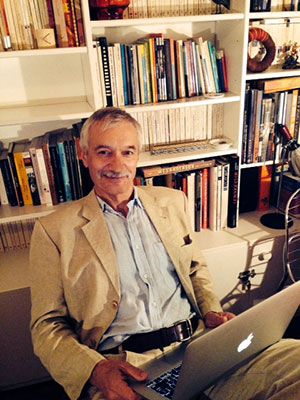
Ian Balitsky, a member of Jefferson Lab’s Theory group and a physics professor at Old Dominion University, has been awarded an ODU Faculty Research Achievement Award. A member of Jefferson Lab’s Theory group has received an Old Dominion University Faculty Research Achievement Award. Ian Balitsky, who is also an ODU professor of physics, accepted the honor at an awards dinner held on May 6. The award is presented each spring to a tenured ODU member who has exhibited consistent excellence in his or her research efforts, according to a news brief posted on Inside ODU. The purpose of the award is to recognize the accomplishments of faculty who achieve national prominence for high-quality research and scholarship. Balitsky, who is a senior staff member of Jefferson Lab’s Theoretical and Computational Physics Division, holds a Jefferson Lab/ODU joint appointment. He earned his Ph.D. in theoretical physics from the Petersburg Nuclear Physics Institute in St. Petersburg, Russia in 1984. He was a postdoctoral associate at Pennsylvania State University from 1992-96 and then a research associate at the Massachusetts Institute of Technology before coming to Virginia in 1996. He started working at ODU as an assistant professor, and was promoted to associate professor with tenure in 2000 and to full professor in 2004. Balitsky is internationally known for his groundbreaking theoretical work in the field of Quantum Chromodynamics, or QCD, the theory that describes how the subatomic particles that make up protons and neutrons in the nucleus – quarks and gluons – interact with each other. His list of publications includes more than 60 papers, which have received more than 7,200 citations. One of his papers, published in 1978, has more than 2,500 citations and a second paper, published in 1996, has surpassed the 1,000-citation mark. The announcement points out that several equations important to the understanding of nuclear behavior are attributed to Balitsky. He was named an American Physical Society Fellow in 2010. In the citation for his fellowship, Balitsky was recognized for his pioneering applications of QCD to hadron physics, in particular, for development of light-cone QCD sum rules and contributions that resulted in Balitsky-Fadin-Kuraev-Lipatov (BFKL) and Balitsky-Kovchegov (BK) equations. The ODU Office of Research sends the nominations it receives for the Faculty Research Achievement Award to the Faculty Senate's Committee on Scholarly Activity and Research, which selects the winners. Award honorees receive a plaque and a check for $2,500. Editor’s note: This brief was excerpted from an ODU announcement, posted online at: |
||||
|
|
||||
Below the Fold: |
||||
Lab Holds Successful Open House; Volunteers Make Event Fun, Informative and Educational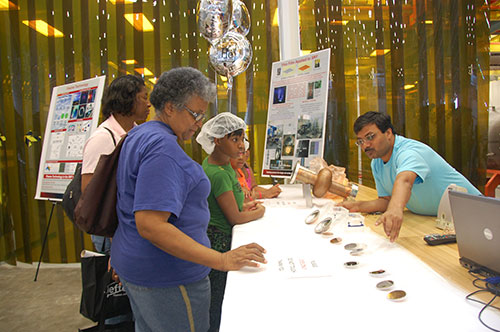
The Jefferson Lab Open House on May 17 attracted thousands of visitors. The event provided the public with access to the CEBAF accelerator and all four experimental halls and most of the major work centers at the lab. These photos show just a few of the areas open that day. A crowd numbering about 6,000 spent the day exploring Jefferson Lab on May 17. In celebration of the upgrade to the CEBAF accelerator, the theme for this year’s event was “Accelerating Discovery.” Access to more areas than any previous open house and enthusiastic volunteers staffing work areas and special displays and helping visitors in a variety of taskings, coupled with mild temperatures and sunny skies helped make the event a great success, according to Kandice Carter, open house coordinator. “The footprint for this open house was the largest ever carried out,” Carter noted. “We had both linear accelerator sections of the Continuous Electron Beam Accelerator Facility open, so guests had two options for viewing the accelerator." More than 2,200 visitors toured the CEBAF accelerator. And, for the first time, all four of the CEBAF experimental halls were open – the three original halls – and the new hall, which is part of the 12 GeV Upgrade project. Hall D is a cornerstone of the $338 million upgrade project, funded by the U.S. Department of Energy's Office of Science and scheduled for completion in 2017. The upgrade will allow the lab to continue as a world leader in nuclear physics research. The project is providing new and enhanced research capabilities for the 1,250 scientists, from more than 250 institutions, who come to Jefferson Lab to conduct experiments. Because of the installation and upgrade work in the halls, a variety of detectors and superconducting magnets were visible, allowing visitors to see systems usually obscured by other equipment. Scientists from local universities – members of the lab’s users community – shared displays of their research, samples of equipment, and items that they use in physics classroom demonstrations with visitors under a big top tent. If they chose to, guests could take in nearly the entire tour route on foot or catch a ride on a shuttle bus. The recently completed, LEED-certified Technology and Engineering Development Building and the newly refurbished Test Lab were open, and visitors could see and hear about superconducting radiofrequency, or SRF, the technology used to propel Jefferson Lab’s electron beam around the accelerator. Hands-on activities in the SRF area included becoming part of a human accelerator, building a miniature cavity and watching live demonstrations of superconductivity. A conference room in the new facility drew crowds for Jefferson Lab science-related talks, ranging from a discussion of the nuclear physics research program carried out at Jefferson Lab, to radiation at the lab and in our world, and the physics most people know about without actually realizing it. The Free-Electron Laser facility was open, and members from the lab’s environmental, safety and health programs staffed special exhibits highlighting sustainability efforts at the lab and industrial safety activities. Science Education staff and volunteers provided a variety of hands-on science activities in the CEBAF Center lobby. Hourly from 10 a.m. – 2 p.m., young and old filled the auditorium for presentations of the always popular Liquid Nitrogen Demonstration. Each of the five shows filled the auditorium, for a total estimated attendance of 1,375. Special displays by the lab’s Radiation Detector and Imaging group and Information Technology Division helped visitors learn about ways the lab’s technology is helping to advance and commercialize new products and processes, and how supercomputing is advancing scientific research through simulation and modeling. Local universities, museums, government agencies and other organizations presented activities and information on complementary scientific endeavors. “These invited participants and the hundreds of members of the lab community who organized the event and volunteered on the day of the open house did an outstanding job. An event of this magnitude takes a lot of effort to conduct, and we are grateful for everyone’s support in making it such a success,” Carter said. There are always lessons to be learned from conducting large events. A survey was offered to guests as they boarded buses returning to the parking lots. And a survey was emailed to the volunteers who worked at the event. Nearly 100 percent of the volunteers reported being extremely or moderately satisfied with the event. Ninety-seven percent said they felt the event was extremely or very well organized. When asked what they liked most about being a volunteer, the comments included: “I am proud to work at JLab and it is always fun to share what we do here with the surrounding community; plus interacting with my co-workers is always fun. The organizers did a great job which made my job as a volunteer more relaxed.” “I enjoyed meeting the public and hearing all the good things they feel Jefferson Lab has contributed to the community.” “Interacting with the public, sharing what I do with them. Talking to families and kids and making them see how fun science and physics can be. Giving advice to students who are interested in physics: what it is like, grad school, the whole shebang.” Ninety-one Staff Members Honored for 1,215 Years of Service to Lab
At three events held between the end of April and the beginning of May, 91 staff members were recognized for respectively completing 5, 10, 15, 20 and 25 years of service at Jefferson Lab. These photos show a couple images from each of the three events. Ninety-one staff members were recognized for their years at Jefferson Lab during a series of annual Service Awards events held between late April and early May. Jefferson Lab staff members who had achieved 5-, 10-, 15-, 20- and 25-year employment anniversaries were recognized at the events, according to Josh Cameron, administrative assistant for Human Resources. The combined years worked by this year's Service Awards recipients totaled 1,215 years. The awards recipients and their respective supervisors attended the events that were hosted by laboratory leadership and planned by Human Resources staff. An ice cream social was held on April 28 in the CEBAF Center cafeteria atrium to recognize the 29 staff members receiving Five-Year Service Awards. Ice cream, bite-sized brownies and a variety of tempting toppings provided a welcome break on a busy afternoon. The casual atmosphere encouraged mingling and animated discussions. Among those celebrating five years with Jefferson Lab was Lab Director Hugh Montgomery. He addressed the group after Rhonda Barbosa, Human Resources manager, kicked off the event. The next morning, a brunch was held in the F113 conference room to recognize the 13 Ten-Year Service Awards recipients and 22 Fifteen-Year recipients. An array of fresh fruits and veggies, smoked salmon, quiche, chicken picatta, scrambled eggs, bacon, sausage and cheese blintzes were served buffet style. Barbosa welcomed the large group and Lab Director Montgomery followed with remarks about the changes that these year groups had experienced during their time at the lab. An Asian-flair, hibachi-grill luncheon was held at noon on May 1 in the F113 conference room – to recognize the 13 Twenty-Year Service Awards recipients and 14 Twenty-Five-Year recipients. The menu featured sushi, salad, honey hoisin BBQ ribs, chicken lo mein, shrimp fried rice, Thai curry vegetables with tofu and spring rolls served buffet style. Barbosa kicked off the event followed by Deputy Director for Science, Bob McKeown, who took the group back to the construction and installation efforts underway 20-25 years ago. Each award recipient received a framed certificate acknowledging and thanking them for their years of service to the lab. The 10/15 and 20/25 receptions also included slide shows featuring photos of past events and photos of those being recognized. And video clips from a lab party held in 1988 were played for the 20/25 year group "Several years ago, based on employee feedback, we moved from one large and lengthy event in the auditorium to this format for recognizing Service Awards recipients," Cameron said. "Human Resources has designed these events to be smaller, more intimate, social events where everyone can talk – share their favorite memories or stories, and catch up with colleagues spread across the lab that they may not see very often." JSA Awards Graduate Fellowships for Research at Jefferson Lab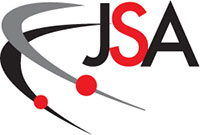 Jefferson Sciences Associates has announced the award of seven JSA/Jefferson Lab graduate fellowships for the 2014-2015 academic year. The doctoral students will use the fellowships to support their advanced studies at their universities and to conduct research at Jefferson Lab. The 2014-15 fellowship winners include: According to a news release issued by JSA on May 29, the students’ research proposals cover a broad scientific spectrum, including experimental physics and accelerator physics and technology. Hardin and Tian are repeat JSA fellowship recipients from the 2013-14 academic year. Each $12,000 fellowship award contributes to the student’s research assistant stipend and is supplemented by support from the home institution. Additional funds are available for research-related travel for the student during the fellowship period. JSA/JLab fellowship recipients attend universities that are members of the Southeastern Universities Research Association, a consortium of more than 60 research universities. Since the program’s inception in 1989 by the SURA Board of Trustees, more than 180 fellowships have been awarded to students from 20 different SURA member universities. The JSA/JLab Graduate Fellowship Program is supported by the JSA Initiatives Fund. The committee that reviewed and selected this year’s fellowship winners was chaired by George JSA/JLab graduate fellowship recipients are chosen based on the quality of their research proposals, their academic standing, and the references of their professors and senior scientists at Jefferson Lab, according to Opper. “The competition this year was very strong with a pool of applicants that was among the best we have experienced in the 25-year history of the program. These fellowship recipients will continue their coursework while enhancing their academic experience with direct interactions and participation with mentors and scientists at the Lab, she said. In a prepared statement, JSA President and Jefferson Lab Director Hugh Montgomery noted, “…During the year, these young researchers will become fully immersed in their research and will tap into the capabilities of the Lab. JSA’s continued support for the Graduate Fellowship Program contributes to the Lab’s achievement of providing data to about one-third of the U.S. Ph.D.’s in nuclear physics each year. This is a key component of the education and training of the next generation of science leaders and the increase of science literacy in society.” This brief was excerpted from the JSA news release, available online at: http://www.jsallc.org/news/JSAIF20140529.pdf Young Researcher is Named Chair-Elect for APS Grad Student Forum
Valerie Gray pauses for a moment between studies at The College of William and Mary and work at Jefferson Lab. She is the chair-elect for the APS Forum on Graduate Student Affairs. Valerie Gray, a graduate student at The College of William and Mary and a member of Jefferson Lab’s users community, was chosen early this year by American Physical Society members as chair-elect for the APS Forum on Graduate Student Affairs (FGSA). The FGSA was created in 2001 to expand graduate students’ involved in the APS and the scientific community at large and to enhance the ability of APS to meet the needs of graduate students. It also offers support services and encourages participation in activities and decision-making in the physics community. It encourages a free exchange of ideas among graduate students and the greater scientific community by providing opportunities for meetings, electronic discussion and access to a permanent archive of member ideas and programs. Gray was born in the small town of Baileys Harbor, Wis., and grew up a self-described “farm kid,” with two brothers and a slew of cousins who all worked on the family farm. “Cows, chickens, hay…a farm needs manpower,” Gray recalled with a laugh. She was the third generation of her family to graduate from the only school in the northern part of the county, which housed kindergarten through 12th grade in the same building. In addition to her farm chores, Gray made money babysitting, working as a waitress at a pizza place, as a sales clerk in an ice cream shop, and handing out putters to tourists at the local mini-golf enterprise. She also played basketball and softball and ran cross country. As early as her days in elementary school, Gray knew her only option for going to college would be to secure a scholarship. There was no way her parents, a carpenter and a seamstress, could afford to send any of their children to college. She also knew that she wouldn’t be pursuing a career in liberal arts. “Me and English? We were like oil and water. History? No way,” she said with a shake of her head. But in math and science she not only excelled, but thrived, and found an excitement that drew her in from the very beginning. With her eye on that future scholarship, she hunkered down and sailed through AP Biology. She raced through mathematics – skipped 8th grade math – and during her senior year in high school took calculus 1 while teaching herself calculus 2. She entered St. Norbert College, a small liberal arts school in DePere, Wis., as a math education major, thinking she would carve out a career as a teacher. While other women her age were reading magazines about hair and makeup, she was reading Popular Mechanics and Popular Science. When her Physics 101 professor, Michael Olson, encouraged her to help in his project developing lab manuals on fuel cells and solar panels for junior high and high school students, she jumped at the chance and her life was changed forever. “Once I got into research…I was gone!” she exclaimed. Throughout Gray’s undergraduate years, her pace never slowed. She worked as a teaching assistant, babysat, and worked in the AmeriCorps office. She spent two summers in Research Experiences for Undergraduates (REU) internship programs, one at Kansas State University and one at Notre Dame, where she worked with Physicist Michael Wiescher, to design and build a support structure for a 6-by-6 foot piece of scintillator, write code and learn to run their accelerators. At the beginning and end of each summer, she made her way home to work on the family farm and other summer jobs. Throughout her senior year, she continued work on her REU project, using Geant4 to simulate incident cosmic-ray muons to evaluate the efficiency of the muon vetoing system on the Van de Graaff beamline at Notre Dame. She received a McNair Scholarship in 2011, which helped pay for her GREs and grad school applications. She came to William and Mary in May 2011 and spent that first summer working at Jefferson Lab with Todd Averett helping to design a prototype Cherenkov detector for the A1n experiment that will run in Hall A (E-12-06-122, Measurement of Neutron Asymmetry A1n the Valence Quark Region). “He pointed me in the direction of (William and Mary Assistant Professor of Physics) Wouter Deconinck, who needed a student,” Gray explained of the next stage of her work. Starting in December 2011, she worked on the Q-weak experiment, calculating the four-momentum transfer for it, and ran Geant4 simulations to test the value. In 2012 and 2013, she traveled to Mainz, Germany, to take part in work going on at the Johannes Gutenberg-Universität for a successor experiment to Q-weak that will be carried out at Mainz. Since December 2012, she has been working on the Atomic Hydrogen Moller Polarimeter, which will be part of her thesis. The polarimeter is intended for use during the Q-weak successor experiment in Mainz and for the SoLID and MOLLER experiments in Jefferson Lab’s Hall A. She has continued as a teaching assistant at William and Mary and helps run the REU program there, setting up events and tours. She also mentors undergraduates and is excited to take on the new duties at chair-elect for the FGSA. “I’m used to being really busy,’’ she said in something of an understatement. Her term started in January; she will assume the chair position next year from Brock Russell, who currently chairs the group. In her role as chair-elect, Gray will help coordinate annual meetings, select those who will receive grant money for travel, and arrange for speakers. She hopes to create a “link local” event in the Washington, D.C., area soon, which will help grad students network and learn about job opportunities. “I’m really excited to be part of this,” she said. Jefferson Lab Still Accepting 6th & 8th Grade Teachers for Science Enrichment ProgramJefferson Lab’s Science Education group is still accepting applications for its science enrichment program for sixth- and eighth-grade teachers of science. "At the elementary- and middle-school levels, teachers, with little or no formal background in science education often find themselves tasked with teaching the science curriculum," says Lisa Surles-Law, JSAT program administrator. "This program is a primer for them and a refresher for those with a formal science education. JSAT provides attendees with a wealth of information, materials and activities to take back to their classrooms, and the opportunity to network with other teachers." The 2014-15 program includes interactive activities to enhance physical science instruction at the upper-elementary and middle-school levels, and lectures by Jefferson Lab staff on the applications of science. Topics will include matter, atomic structure, energy transfer, force and motion, magnetism and electricity, waves and sound, simple machines, optics and the watershed cycle. Program participants receive supplies and materials so they will be able to conduct all the planned activities in their own classrooms. Participating teachers can earn up to 48 recertification points for 2014-15. The JSAT program, funded by a grant from the Jefferson Science Associates Initiatives Fund, addresses components of National Science Education Standards and the Virginia Standards of Learning. Fifth-grade teachers meet on alternating Thursday nights (this section is full), sixth-grade teachers meet on alternating Tuesday evenings, and eighth-grade teachers meet on alternating Wednesdays. The sessions take place from 5-7 p.m. at Jefferson Lab, located at 12000 Jefferson Ave. in Newport News. Additional information, program dates and the application form are available online at: The JSA Initiatives Fund Program was established by Jefferson Science Associates, to support programs, initiatives and activities that further the scientific outreach, and promote the science, education and technology missions of Jefferson Lab in ways that complement its basic and applied research focus. Initiatives Fund awards are for those projects that benefit the lab user community and that leverage commitments of others. JSA, a joint venture between the Southeastern Universities Research Association and PAE Applied Technologies, manages and operates Jefferson Lab for the U.S. Department of Energy. Information about the JSA Initiatives Fund program is online at: www.jsallc.org/IF/IFIndex.html. Milestones for June - July 2014Hello LaShaunda Armstrong, Procurement Administrator II, Chief Financial Officer Division Goodbye Martha Hightower, Chief Financial Officer Division These Milestone entries are full-time, term, casual and student actions provided by Human Resources and listed alphabetically for June - July 2014. Jefferson Lab is currently seeking qualified individualsfor a dozen positions, including postdoctoral fellow, financial and information technology managers, IT system administrator, electrical safety technician, and co-op and student intern positions. All current employment opportunities are posted at: https://careers.peopleclick.com/careerscp/client_jeffersonlab/external/search.do In Memoriam:
|
||||
|
The On Target newsletter is published by the Thomas Jefferson National Accelerator Facility (Jefferson Lab), a nuclear physics research laboratory in Newport News, Virginia, operated by Jefferson Science Associates, LLC, for the U.S. Department of Energy's Office of Science. Possible news items and ideas for future stories may be emailed to jlabinfo@jlab.org, or sent to the Jefferson Lab Public Affairs Office, Suite 15, 12000 Jefferson Avenue, Newport News, VA 23606
|
||||


 In conjunction with the inaugural
In conjunction with the inaugural  Secretary of Energy Ernest Moniz joined Senator Dick Durbin (D-IL) and Senator Jim Risch (R-ID) for National Lab Day on the Hill on Sept. 16.......
Secretary of Energy Ernest Moniz joined Senator Dick Durbin (D-IL) and Senator Jim Risch (R-ID) for National Lab Day on the Hill on Sept. 16....... 
